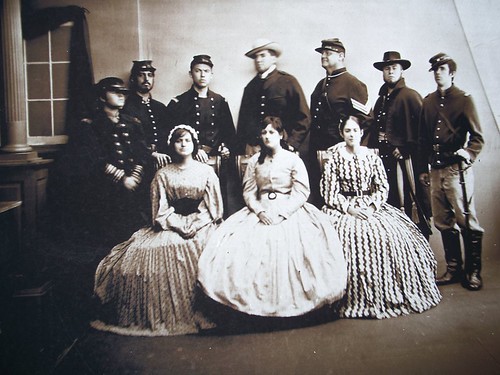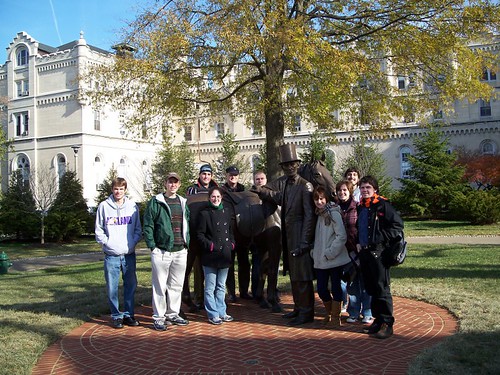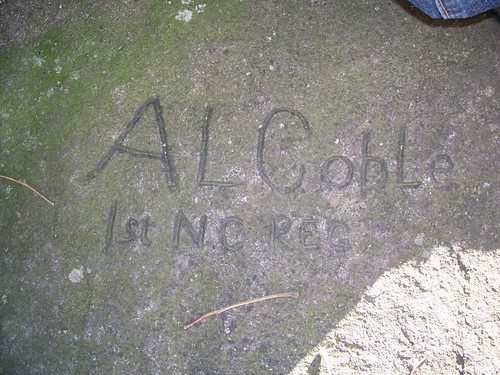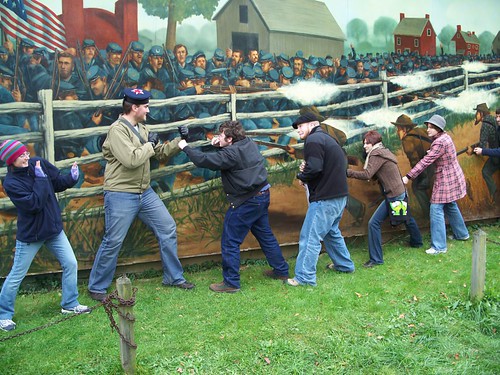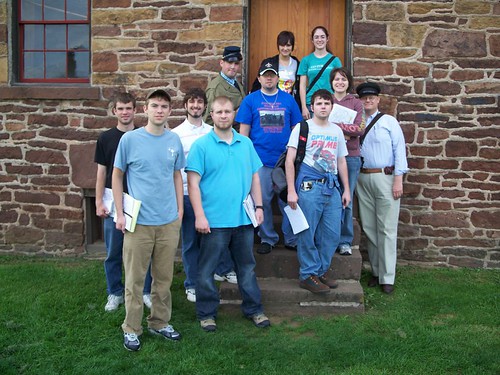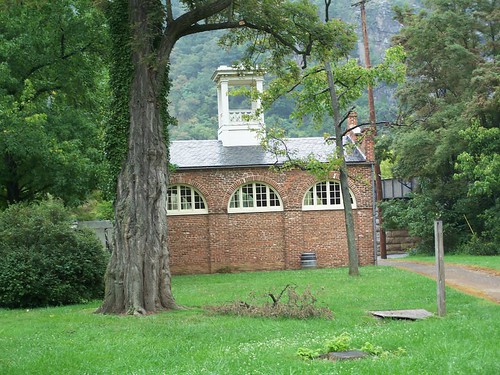Friday, December 12, 2008
Gettysburg Semester: Muster Out
Friday, December 5, 2008
Gettysburg Semester: Washington, D.C.
 Today was our last field experience trip…to Washington DC! We started out in front of the White House and Lafayette Square to talk about Lincoln’s wartime Washington. Then we went to Fort Stevens to talk about the attack on Washington in 1864 by Jubal Early. Fort Stevens was one on many forts in the defenses of the capital and it was the only fort that was really attacked in the war. We know that Lincoln went out to watch the battle and it is reported that he climbed on top of the parapet until he was yelled at by one of the officers. Our last stop before lunch was the Lincoln Cottage at the Old Soldiers’ Home. This was the Lincolns’ summer home during his presidency and it was an important place for President Lincoln to formulate his ideas about the war. We were led through the house by a former Gettysburg Semester student and were some of the first people to see the new statue that was just put in a few weeks ago.
Today was our last field experience trip…to Washington DC! We started out in front of the White House and Lafayette Square to talk about Lincoln’s wartime Washington. Then we went to Fort Stevens to talk about the attack on Washington in 1864 by Jubal Early. Fort Stevens was one on many forts in the defenses of the capital and it was the only fort that was really attacked in the war. We know that Lincoln went out to watch the battle and it is reported that he climbed on top of the parapet until he was yelled at by one of the officers. Our last stop before lunch was the Lincoln Cottage at the Old Soldiers’ Home. This was the Lincolns’ summer home during his presidency and it was an important place for President Lincoln to formulate his ideas about the war. We were led through the house by a former Gettysburg Semester student and were some of the first people to see the new statue that was just put in a few weeks ago.  After a lunch at the Hard Rock Café, we went to Ford’s Theatre where Lincoln was shot. We couldn’t go inside the theatre because it was still being renovated, but we stood outside while Dr. Guelzo described the night he was shot. Then we went inside the Petersen House where Lincoln died. We saw the parlor where Mary Todd Lincoln spent much of her time that night, the back parlor where national officials held meetings, and the bad bedroom where Lincoln was brought until he died. Our last stop was Lincoln Memorial, a fitting end to our field experience trips.
After a lunch at the Hard Rock Café, we went to Ford’s Theatre where Lincoln was shot. We couldn’t go inside the theatre because it was still being renovated, but we stood outside while Dr. Guelzo described the night he was shot. Then we went inside the Petersen House where Lincoln died. We saw the parlor where Mary Todd Lincoln spent much of her time that night, the back parlor where national officials held meetings, and the bad bedroom where Lincoln was brought until he died. Our last stop was Lincoln Memorial, a fitting end to our field experience trips.
Next week we will be saying good-bye to each other and Gettysburg at our mustering-out party.
Sunday, November 16, 2008
Gettysburg Semester: Richmond Trip (Appomattox Court House)
 We headed out early for the final day of our Richmond weekend. Our only stop for the day was Appomattox Court House where Lee finally surrendered to Grant's Union forces. At the visitor center (located in the court house itself) we met our guide, Bert Dunkerly, who took us on a tour of the village. Many of the original buildings still stand and others are reconstructed. Unfortunately for us it had finally decided to feel like November and the wind was really cold. It didn't dampen our enthusiasm though.
We headed out early for the final day of our Richmond weekend. Our only stop for the day was Appomattox Court House where Lee finally surrendered to Grant's Union forces. At the visitor center (located in the court house itself) we met our guide, Bert Dunkerly, who took us on a tour of the village. Many of the original buildings still stand and others are reconstructed. Unfortunately for us it had finally decided to feel like November and the wind was really cold. It didn't dampen our enthusiasm though.
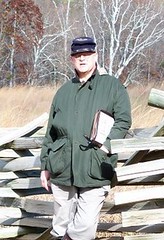 Bert took us from one end of the village, where the battle was fought on April 9, to the other end, where Grant and Lee met a second time and also where the parade began in the surrender ceremony. In between we saw the McLean house where the surrender terms were drawn up and signed and the tavern where over 28,000 paroles were printed for the Confederate soldiers. When our tour was done we were let loose to explore the buildings and exhibits on our own. It was really awesome to be able to stand in the same room as Grant and Lee had stood. After lunch and a treat at Dairy Queen we boarded back into the van for the long ride back to Gettysburg.
Bert took us from one end of the village, where the battle was fought on April 9, to the other end, where Grant and Lee met a second time and also where the parade began in the surrender ceremony. In between we saw the McLean house where the surrender terms were drawn up and signed and the tavern where over 28,000 paroles were printed for the Confederate soldiers. When our tour was done we were let loose to explore the buildings and exhibits on our own. It was really awesome to be able to stand in the same room as Grant and Lee had stood. After lunch and a treat at Dairy Queen we boarded back into the van for the long ride back to Gettysburg.
The war may have ended for Generals Grant and Lee at Appomattox, but our journey is not over yet. After our break for Thanksgiving, we go to the nation's capital...Washington DC!
Saturday, November 15, 2008
Gettysburg Semester: Richmond Trip (Cold Harbor & Petersburg)
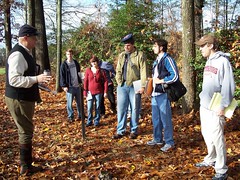 Our first battlefield on the second day of our Richmond trip was Cold Harbor where we were led by our own Dr. Allen C. Guelzo. We quickly shed our coats in the unseasonable warm weather and followed him on a very nice trail through the woods that covered the former battlefield. Unfortunately, only a very small area of the battlefield remains and that is covered in thick woods. So, while it was nice to walk through the woods, it was very hard to see the battlefield. A good portion of the trenches were preserved in that area, however, so that helped a lot. Dr. Guelzo took us through the battles on June 1 and June 3 that constituted the third thrust of Grant in his Overland Campaign. After walking the trail where the II and VI Union Corps attacked, we headed down a bit farther to where the XVIII Corps attacked. Our final stop was at the only monument on the battlefield, that of the 2nd Connecticut Heavy Artillery which constituted the majority of the force attacking on June 1 and took heavy casualties.
Our first battlefield on the second day of our Richmond trip was Cold Harbor where we were led by our own Dr. Allen C. Guelzo. We quickly shed our coats in the unseasonable warm weather and followed him on a very nice trail through the woods that covered the former battlefield. Unfortunately, only a very small area of the battlefield remains and that is covered in thick woods. So, while it was nice to walk through the woods, it was very hard to see the battlefield. A good portion of the trenches were preserved in that area, however, so that helped a lot. Dr. Guelzo took us through the battles on June 1 and June 3 that constituted the third thrust of Grant in his Overland Campaign. After walking the trail where the II and VI Union Corps attacked, we headed down a bit farther to where the XVIII Corps attacked. Our final stop was at the only monument on the battlefield, that of the 2nd Connecticut Heavy Artillery which constituted the majority of the force attacking on June 1 and took heavy casualties.
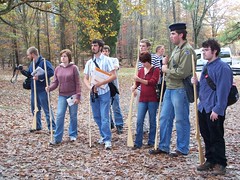 After lunch we made our way to Petersburg to cover the final stop of the Overland Campaign. Here the two armies settled into a siege that lasted 9 months and 18 days and sounded the death knell for the Confederacy. At the visitor center we met up with our guide for the afternoon, Randy Watkins. The first thing he did was drill us on the 12-pounder Napoleon outside the visitor center door. We made a lot of mistakes the first time, but by the third try we were making progress! Then we headed to a reconstructed fortification where he drilled us with wooden muskets. It was confusing at first, but a lot of fun! That done we settled down to learn about the siege and its battles.
After lunch we made our way to Petersburg to cover the final stop of the Overland Campaign. Here the two armies settled into a siege that lasted 9 months and 18 days and sounded the death knell for the Confederacy. At the visitor center we met up with our guide for the afternoon, Randy Watkins. The first thing he did was drill us on the 12-pounder Napoleon outside the visitor center door. We made a lot of mistakes the first time, but by the third try we were making progress! Then we headed to a reconstructed fortification where he drilled us with wooden muskets. It was confusing at first, but a lot of fun! That done we settled down to learn about the siege and its battles.
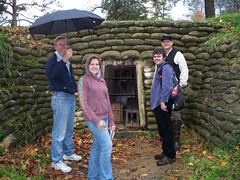 We went to three different forts along the Union line-Fort Stedman, Fort Wadsworth, and Fort Fisher where battles occurred at different times. The forts are only rows of grassy mounds now, but we could still get a sense of the life led during the siege. Probably the stop that we were all looking forward to most was the Crater. This is where the Union dug a 511-foot tunnel under the Confederate works, filled it with 8,000 pounds of gunpowder, and blew it up killing 318 Confederates and creating a huge crater in the ground. Even though we got stuck in a rainstorm at this stop we were excited to see the reconstructed entrance to the tunnel and then the Crater itself. It doesn't look like much now, just a big grassy depression, but it must have looked amazing when it first happened. Once darkness forced us off the field we said goodbye to Randy and headed off to dinner at the Brickhouse run in Petersburg.
We went to three different forts along the Union line-Fort Stedman, Fort Wadsworth, and Fort Fisher where battles occurred at different times. The forts are only rows of grassy mounds now, but we could still get a sense of the life led during the siege. Probably the stop that we were all looking forward to most was the Crater. This is where the Union dug a 511-foot tunnel under the Confederate works, filled it with 8,000 pounds of gunpowder, and blew it up killing 318 Confederates and creating a huge crater in the ground. Even though we got stuck in a rainstorm at this stop we were excited to see the reconstructed entrance to the tunnel and then the Crater itself. It doesn't look like much now, just a big grassy depression, but it must have looked amazing when it first happened. Once darkness forced us off the field we said goodbye to Randy and headed off to dinner at the Brickhouse run in Petersburg.
Tomorrow is our last day of the three day tour and we are fittingly covering the last day of the eastern campaign.....Appomattox Court House.
Friday, November 14, 2008
Gettysburg Semester: Richmond Trip (Wilderness & Spotsylvania)
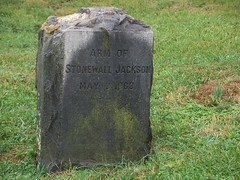 We began at Elwood where Don introduced us to the Union side of the battle and we paid tribute to Stonewall Jackson (even though that was technically connected to the Battle of Chancellorsville) by visiting the place where his amputated arm is buried. We talked about Warren a great deal here since this was his Headquarters in the Wilderness, and after Don said that he liked limericks Dr. Guelzo tried his hand at creating one about Warren himself. Then we went to Saunder's Field were the Battle of the Wilderness began. There Don covered the Confederate side of the campaign and the beginning of the battle. We followed the Confederate lines from the Orange Turnpike to the Orange Plank Road were we visited the Chewning and Widow Tapp's Farms. Heading down the Orange Plank Road we followed the path of Longstreet's advance and saw where he was accidently wounded by his own men. After covering the other end of the battle at the intersection of the Brock Road we headed towards Spotsylvania Courthouse for lunch.
We began at Elwood where Don introduced us to the Union side of the battle and we paid tribute to Stonewall Jackson (even though that was technically connected to the Battle of Chancellorsville) by visiting the place where his amputated arm is buried. We talked about Warren a great deal here since this was his Headquarters in the Wilderness, and after Don said that he liked limericks Dr. Guelzo tried his hand at creating one about Warren himself. Then we went to Saunder's Field were the Battle of the Wilderness began. There Don covered the Confederate side of the campaign and the beginning of the battle. We followed the Confederate lines from the Orange Turnpike to the Orange Plank Road were we visited the Chewning and Widow Tapp's Farms. Heading down the Orange Plank Road we followed the path of Longstreet's advance and saw where he was accidently wounded by his own men. After covering the other end of the battle at the intersection of the Brock Road we headed towards Spotsylvania Courthouse for lunch.
 After lunch at the Courthouse Café we headed to the location of Sedgwick's death to begin the Battle of Spotsylvania Courthouse. He was killed on the approach to Laurel Hill where the battle would begin, the Confederates having beaten the Federals to Spotsylvania Courthouse. Laurel Hill would form half of the battlefield where several Union assaults would occur over the days of the battle. Then we went to the famous "Mule Shoe" salient in the Confederate lines. Don took us first to the center of the salient where the first Union assault was led by Upton through the Confederate lines. He gave us an overview of the attacks there on May 10th and 12th and then we went to "Bloody Angle" where Union and Confederate troops fought hand-to-hand for 20 hours on May 12th. We got to go down behind a line of reconstructed earthworks that were the beginnings of the lines of gentle mounds that line the field today.
After lunch at the Courthouse Café we headed to the location of Sedgwick's death to begin the Battle of Spotsylvania Courthouse. He was killed on the approach to Laurel Hill where the battle would begin, the Confederates having beaten the Federals to Spotsylvania Courthouse. Laurel Hill would form half of the battlefield where several Union assaults would occur over the days of the battle. Then we went to the famous "Mule Shoe" salient in the Confederate lines. Don took us first to the center of the salient where the first Union assault was led by Upton through the Confederate lines. He gave us an overview of the attacks there on May 10th and 12th and then we went to "Bloody Angle" where Union and Confederate troops fought hand-to-hand for 20 hours on May 12th. We got to go down behind a line of reconstructed earthworks that were the beginnings of the lines of gentle mounds that line the field today.
Our last stop was at Massaponax Church were O'Sullivan's famous picture was taken of Grant and Meade with their subordinates. Then we headed south for dinner and some well deserved rest. Tomorrow we go to Cold Harbor and Petersburg!
Friday, November 7, 2008
Gettysburg Semester: Gettysburg (Day 3)
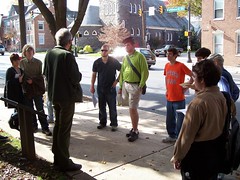 Ranger John Heiser met us at the Appleford to begin our third and final tour of Gettysburg (at least with the Semester-I know this won't be my last time!). We started out with a drive around the battlefield looking at the Culp Farm, the Bushman Farm, and the Trostle Farm to understand the toll the battle took on local farmers. Then we headed back into town to learn about the impact on the town and its citizens. He took us through streets and alleys to see the railroad station, the GAR post, and several churches that had been used as hospitals. The impact of civilians was told through stories, such as the story of Sally Mires, a 20-year old schoolteacher who worked with the wounded for several days in St. Francis Xavier Church even though the first time she entered she had broken down and had to leave.
Ranger John Heiser met us at the Appleford to begin our third and final tour of Gettysburg (at least with the Semester-I know this won't be my last time!). We started out with a drive around the battlefield looking at the Culp Farm, the Bushman Farm, and the Trostle Farm to understand the toll the battle took on local farmers. Then we headed back into town to learn about the impact on the town and its citizens. He took us through streets and alleys to see the railroad station, the GAR post, and several churches that had been used as hospitals. The impact of civilians was told through stories, such as the story of Sally Mires, a 20-year old schoolteacher who worked with the wounded for several days in St. Francis Xavier Church even though the first time she entered she had broken down and had to leave.
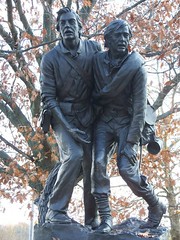 After a tasty lunch at O'Rorke's and ice cream at Kilwin's we met up with our second guide, Ranger Scott Hartwig, who would lead us through Pickett's Charge. We started at the Union lines where Scott got us oriented to where the battle stood on the morning of July 3rd and who the troops were that would defend the ridge against the famous assault of Pickett, Pettigrew, and Trimble. Then we walked over to the Confederate side to get that perspective of the day's battle. There Scott told us about the problems with command and communication the Confederates faced that day and how the charge was decided on and organized. Then we walked the path of Pickett's Division back to the Union line. This was made all the more realistic by our own walking casualty. Amy gamely walked, or should I say hobbled, the two miles on her bad ankle. The dedication of the Confederate men that made the original assault lives on!
After a tasty lunch at O'Rorke's and ice cream at Kilwin's we met up with our second guide, Ranger Scott Hartwig, who would lead us through Pickett's Charge. We started at the Union lines where Scott got us oriented to where the battle stood on the morning of July 3rd and who the troops were that would defend the ridge against the famous assault of Pickett, Pettigrew, and Trimble. Then we walked over to the Confederate side to get that perspective of the day's battle. There Scott told us about the problems with command and communication the Confederates faced that day and how the charge was decided on and organized. Then we walked the path of Pickett's Division back to the Union line. This was made all the more realistic by our own walking casualty. Amy gamely walked, or should I say hobbled, the two miles on her bad ankle. The dedication of the Confederate men that made the original assault lives on!
We ended the day near the Angle and the Copse of Trees where Armistead broke through the Union lines and was repelled. Here I presented on my 69th Pennsylvania boys who single-handedly pushed the Confederates back! Ok, maybe I exaggerate, but they were crucial in the fighting that took place there.
The Battle of Gettysburg would end with the ill-fated charge of the Confederates. Pickett's Charge was also the end of our three day tour of Gettysburg. Fortunately, it does not mark the end of our field experience trips and next week we are going to the Richmond area for a three day tour!!
Friday, October 31, 2008
Gettysburg Semester: Gettysburg (Day 2)
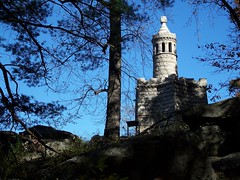 Our first stop was by the North Carolina monument on the Confederate lines. John used this position to lay out the Union and Confederate lines at the start of day two and gave us an overview of what happened in the course of the fighting. We began with the Union left and Sickles’ III Corps. We did a loop of the III Corps line starting at the Peach Orchard, then going to Little Round Top, and ending up in the middle by the Wheatfield.
Our first stop was by the North Carolina monument on the Confederate lines. John used this position to lay out the Union and Confederate lines at the start of day two and gave us an overview of what happened in the course of the fighting. We began with the Union left and Sickles’ III Corps. We did a loop of the III Corps line starting at the Peach Orchard, then going to Little Round Top, and ending up in the middle by the Wheatfield.
At Little Round Top John focused on the Union line at the face of the hill (since the 20th Maine is emphasized everywhere else) and we discussed the weak position of Sickles’ line in relation to the rest of the Union line. At the stony hill near the Wheatfield we were in the middle of Sickles’ line and heard about how the Union line began collapsing under the Confederates’ echelon attack. Then it was time for lunch at Pickett’s Buffet!
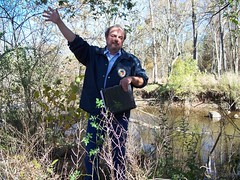 After lunch we headed to the center of the Union line on Cemetery Hill where Lee’s attack failed once it really started to work. We covered that briefly, and then moved to one of John’s favorite places-Culp’s Hill. We began on Benner’s Hill to see where the Confederate artillery was placed and where the infantry would make their attack from. Then we went to the other side of Rock Creek to the Union lines. John brought us to see one of the little known secrets of the battlefield- A.L. Coble from the 1st NC came back after the battle and carved his name in a rock where he had been fighting. We had to climb a huge rock to see it and unfortunately my roommate, Amy, fell and injured her ankle. We continued with the battle for Culp’s Hill and progressed over Steven’s Knoll to Cemetery Hill.
After lunch we headed to the center of the Union line on Cemetery Hill where Lee’s attack failed once it really started to work. We covered that briefly, and then moved to one of John’s favorite places-Culp’s Hill. We began on Benner’s Hill to see where the Confederate artillery was placed and where the infantry would make their attack from. Then we went to the other side of Rock Creek to the Union lines. John brought us to see one of the little known secrets of the battlefield- A.L. Coble from the 1st NC came back after the battle and carved his name in a rock where he had been fighting. We had to climb a huge rock to see it and unfortunately my roommate, Amy, fell and injured her ankle. We continued with the battle for Culp’s Hill and progressed over Steven’s Knoll to Cemetery Hill.
 After the bus scared us by turning its back up lights while five of us were still behind it (trying to help Amy hobble along) we crossed the road to finish up our tour with the battle for Cemetery Hill. Here another breakthrough occurred but was not supported and so Lee’s battle plans for July 2 failed. Then it was time to head back to the Appleford. We headed back to the bus but a low stone wall blocked our path. As Amy looked uneasily at the climb, Alex picked her up and started across the wall. Unfortunately he didn’t get very far as he slipped and fell (he was fine besides a few bruises). The afternoon ended as a “comedy of errors” with two more casualties of the Civil War.
After the bus scared us by turning its back up lights while five of us were still behind it (trying to help Amy hobble along) we crossed the road to finish up our tour with the battle for Cemetery Hill. Here another breakthrough occurred but was not supported and so Lee’s battle plans for July 2 failed. Then it was time to head back to the Appleford. We headed back to the bus but a low stone wall blocked our path. As Amy looked uneasily at the climb, Alex picked her up and started across the wall. Unfortunately he didn’t get very far as he slipped and fell (he was fine besides a few bruises). The afternoon ended as a “comedy of errors” with two more casualties of the Civil War.
Hopefully, our troops with have recovered by next week when we cover Day 3 and Pickett’s Charge!
-Katie Logothetis
Friday, October 24, 2008
Gettysburg Semester: Gettysburg (Day 1)
 Although cold and cloudy we departed for the very long drive to our own backyard-Gettysburg!! Our guide, John Archer, met us at the Appleford and we drove out to start our tour on East Cemetery Hill. There John gave us an overview of the events leading up to the battle and oriented us to the terrain. East Cemetery Hill was the “fall-back” position of the Union, so it was important to keep it in mind when we were discussing the fight and retreat of the first day.
Although cold and cloudy we departed for the very long drive to our own backyard-Gettysburg!! Our guide, John Archer, met us at the Appleford and we drove out to start our tour on East Cemetery Hill. There John gave us an overview of the events leading up to the battle and oriented us to the terrain. East Cemetery Hill was the “fall-back” position of the Union, so it was important to keep it in mind when we were discussing the fight and retreat of the first day.
 After East Cemetery Hill we drove a few miles out of town to where the first shot of the battle was fired. There we learned about Buford’s delaying tactics and Heth’s quest for “shoes”. Then we followed Buford’s planned retreat to Herr Ridge and McPherson Ridge where the infantry battle would be joined. We went to the railroad cut to see where Davis’ brigade had met with the I Corps and into Herbst Woods where Archer’s Brigade clashed with the Iron Brigade. John is a descendant of James J. Archer and so he told us the story of Archer’s capture in that assault. Once we were done there we traveled across the railroad cut to where the XI Corps came into action against Rodes’ Division. After going to Oak Hill and the Gettysburg Plains below, it was time for lunch.
After East Cemetery Hill we drove a few miles out of town to where the first shot of the battle was fired. There we learned about Buford’s delaying tactics and Heth’s quest for “shoes”. Then we followed Buford’s planned retreat to Herr Ridge and McPherson Ridge where the infantry battle would be joined. We went to the railroad cut to see where Davis’ brigade had met with the I Corps and into Herbst Woods where Archer’s Brigade clashed with the Iron Brigade. John is a descendant of James J. Archer and so he told us the story of Archer’s capture in that assault. Once we were done there we traveled across the railroad cut to where the XI Corps came into action against Rodes’ Division. After going to Oak Hill and the Gettysburg Plains below, it was time for lunch.
 After lunch we went to Barlow’s Knoll to cover the right flank of the XI Corps and begin the retreat through the town. Blocher’s Knoll (as it was then called) was the sight of a crushing defeat for the XI Corps. The I and XI Corps crumbled around the same time, so we headed back to Herbst Woods to cover the retreat of the Iron Brigade. John led us through the woods following the path of the 24th Michigan and we continued to follow them back to Seminary Ridge. Then we went to the site of Kuhn’s Brickyard where a fierce fight took place to cover the retreat of the XI Corps. The Brickyard is inconspicuous, surrounded by houses, but it stands out for the large mural of the battle painted on the side of the building. It was so commanding that we posed in battle positions in front of it. For some strange reason those on the Confederate side outnumbered those on the Union. I stood on the Union side, but not very bravely since I realistically portrayed how I would be in battle: cowering behind someone else (there has to be one coward in a unit and I guess I’m it).
After lunch we went to Barlow’s Knoll to cover the right flank of the XI Corps and begin the retreat through the town. Blocher’s Knoll (as it was then called) was the sight of a crushing defeat for the XI Corps. The I and XI Corps crumbled around the same time, so we headed back to Herbst Woods to cover the retreat of the Iron Brigade. John led us through the woods following the path of the 24th Michigan and we continued to follow them back to Seminary Ridge. Then we went to the site of Kuhn’s Brickyard where a fierce fight took place to cover the retreat of the XI Corps. The Brickyard is inconspicuous, surrounded by houses, but it stands out for the large mural of the battle painted on the side of the building. It was so commanding that we posed in battle positions in front of it. For some strange reason those on the Confederate side outnumbered those on the Union. I stood on the Union side, but not very bravely since I realistically portrayed how I would be in battle: cowering behind someone else (there has to be one coward in a unit and I guess I’m it).
Our last stop was near (but not on) Cemetery Hill to discuss the decision of Ewell to not continue the attack on the Union position once they had regrouped on Cemetery Hill. Next week we continue the Gettysburg saga with the second day of the battle.
-Katie Logothetis
Friday, October 10, 2008
Gettysburg Semester: Winchester
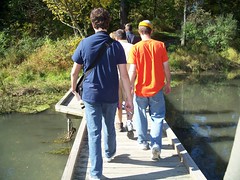 We picked up Dennis Fry at Harpers Ferry and then continued on into the valley. The first three stops we made were on the side of the road: the first at the site of Mosby's Berryville Wagon Train Raid, the second at Beemer's Woods, and the third just before the Berryville Canyon. The battlefields of the Valley have not been well preserved. None of the sites are part of the National Parks System. Dennis Fry, with the Civil War Preservation Trust, worked hard to save pieces of the battles at Winchester and Cedar Creek. Dennis took us on a trail through the preserved part of the Battle of Third Winchester to give us a look at that battle which had occurred during the 1864 campaign. It was beautiful walking through the fields and woods around Red Bull Run, but the houses and highways visible around the property were a sad reminder of how much had not been preserved. We then drove to the location of the two battles of Kernstown (one in 1862 and one in 1864). The land around the Pritchard Farm and Sandy Ridge has been preserved by the Kernstown Battlefield Association, a local organization.
We picked up Dennis Fry at Harpers Ferry and then continued on into the valley. The first three stops we made were on the side of the road: the first at the site of Mosby's Berryville Wagon Train Raid, the second at Beemer's Woods, and the third just before the Berryville Canyon. The battlefields of the Valley have not been well preserved. None of the sites are part of the National Parks System. Dennis Fry, with the Civil War Preservation Trust, worked hard to save pieces of the battles at Winchester and Cedar Creek. Dennis took us on a trail through the preserved part of the Battle of Third Winchester to give us a look at that battle which had occurred during the 1864 campaign. It was beautiful walking through the fields and woods around Red Bull Run, but the houses and highways visible around the property were a sad reminder of how much had not been preserved. We then drove to the location of the two battles of Kernstown (one in 1862 and one in 1864). The land around the Pritchard Farm and Sandy Ridge has been preserved by the Kernstown Battlefield Association, a local organization.
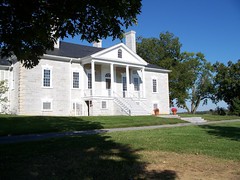 After a wonderful lunch at the historic Wayside Inn we headed out to Fisher's Hill to learn about the battle of Winchester in 1864. Dennis had also been part of the purchase and preservation of this site. We climbed the Confederate positions on Fisher's Hill to study the terrain and movements of both armies. There was a trail but we did a lot of "off-roading", and I have never seen so many crickets in my life! It was getting late so we made one final stop at Belle Grove Plantation to discuss the Battle of Cedar Creek. Part of our focus was turned towards the quarry that mars part of the landscape nearby.
After a wonderful lunch at the historic Wayside Inn we headed out to Fisher's Hill to learn about the battle of Winchester in 1864. Dennis had also been part of the purchase and preservation of this site. We climbed the Confederate positions on Fisher's Hill to study the terrain and movements of both armies. There was a trail but we did a lot of "off-roading", and I have never seen so many crickets in my life! It was getting late so we made one final stop at Belle Grove Plantation to discuss the Battle of Cedar Creek. Part of our focus was turned towards the quarry that mars part of the landscape nearby.
As we made our way back to Harpers Ferry to drop off and say good-by to Dennis, I realized that this tour had educated us in more than just battles and troop movements. It was a reminder of how much history is threatened and how easily it can be lost.
Next time we start my favorite battlefield of all.......Gettysburg!
-Katie Logothetis

Friday, October 3, 2008
Gettysburg Semester: Antietam
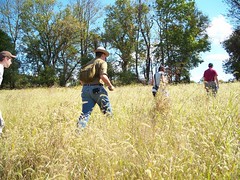 The first week of October found us traveling to Sharpsburg, Maryland where the bloodiest one day battle in America was fought. 23,000 men were killed, wounded, or captured on this field in September 1862 making it one of the greatest battles in American history. The Maryland Campaign and the battle of Antietam were very influential actions in the war; a lot depended on who would win this contest.
The first week of October found us traveling to Sharpsburg, Maryland where the bloodiest one day battle in America was fought. 23,000 men were killed, wounded, or captured on this field in September 1862 making it one of the greatest battles in American history. The Maryland Campaign and the battle of Antietam were very influential actions in the war; a lot depended on who would win this contest.
We left early with Cathy Bain as a fearless leader since Dr. Guelzo was feeling "under the weather". Dennis Frye met us at the visitor center and we began our tour on the ground that Lee held during the battle. The morning was spent analyzing McClellan and Lee's actions and options in the overarching campaign and in the positions along the Antietam Creek. Dennis challenged us to think beyond what most historians write about McClellan and think in "real-time" history with only the knowledge that they had at the time on the field.
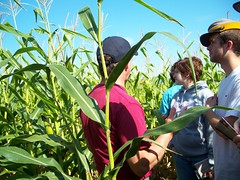 After lunch we began analyzing the battle itself. Crucial to Dennis' considerations of McClellan were the actions of General Burnside at the Lower bridge. Dennis brought us "off-roading" up in the hills overlooking the Antietam Creek on the Union side so we could analyze Burnside's position. By "off-roading" I mean we hiked through fields of knee high grass, made our way through a heavily vegetated ravine, and were attacked by crickets (or at least I was)! We definitely got a unique view of the battlefield and the tactics and strategy involved in planning an offensive. After we had
After lunch we began analyzing the battle itself. Crucial to Dennis' considerations of McClellan were the actions of General Burnside at the Lower bridge. Dennis brought us "off-roading" up in the hills overlooking the Antietam Creek on the Union side so we could analyze Burnside's position. By "off-roading" I mean we hiked through fields of knee high grass, made our way through a heavily vegetated ravine, and were attacked by crickets (or at least I was)! We definitely got a unique view of the battlefield and the tactics and strategy involved in planning an offensive. After we had finished at "Burnside's Bridge" we headed off to the center of the Confederate lines: "Bloody Lane". Here we did a time honored Gettysburg Semester tradition: "The Bloat". We reenacted the famous picture of Confederate dead in the sunken road taken by Alexander Gardner, assistant to Matthew Brady. Then we went to the cornfield to finish up our tour. Dennis actually took us into the cornfield which was very intimidating for someone who is only 5'2"!
finished at "Burnside's Bridge" we headed off to the center of the Confederate lines: "Bloody Lane". Here we did a time honored Gettysburg Semester tradition: "The Bloat". We reenacted the famous picture of Confederate dead in the sunken road taken by Alexander Gardner, assistant to Matthew Brady. Then we went to the cornfield to finish up our tour. Dennis actually took us into the cornfield which was very intimidating for someone who is only 5'2"!
Next week we will be traveling in the beautiful Shenandoah Valley to study Jackson's Valley Campaign.
-Katie Logothetis
Friday, September 19, 2008
Gettysburg Semester: Manassas
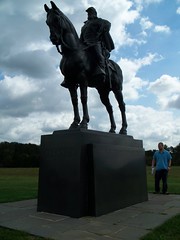 We started off with the First Battle of Manassas. The First Battle of Manassas was the first major campaign of the war, fought in July of 1861, and the North was confident that they would win the engagement and end the rebellion quickly. Jim took us first to the Stone Bridge over Bull Run that was the sight of the first shots of the battle in a diversionary tactic by the Union. Then we went to the area that was the main battlefield for his engagement: Matthew's Hill and Henry House Hill. The main fighting began by Matthew's Hill and was pushed back to Henry Hill for the remainder of the battle. This is where Thomas Jonathan Jackson gained the nickname that would forever stick: "Stonewall" Jackson.
We started off with the First Battle of Manassas. The First Battle of Manassas was the first major campaign of the war, fought in July of 1861, and the North was confident that they would win the engagement and end the rebellion quickly. Jim took us first to the Stone Bridge over Bull Run that was the sight of the first shots of the battle in a diversionary tactic by the Union. Then we went to the area that was the main battlefield for his engagement: Matthew's Hill and Henry House Hill. The main fighting began by Matthew's Hill and was pushed back to Henry Hill for the remainder of the battle. This is where Thomas Jonathan Jackson gained the nickname that would forever stick: "Stonewall" Jackson.
After lunch Jim took us out to the Brawner Farm to begin the Second Battle of Manassas. The amazing element in both battles is that they were fought on such small areas of land. We only had to make only a few stops to see the majority of the battlefield. The Brawner Farm was the flank of the Confederate lines and also where the famed Iron Brigade earned its name. From the Brawner Farm we moved to where the Union made its main assault on the Confederates at the unfinished railroad cut. Here Dr. Guelzo got tired of our slow pace and had us march in column formation which we did much better than our line formation last week, especially since Dr. Guelzo led us in some marching songs. Our last stop before hitting the bookstore at the Visitor Center was Chinn Ridge where the Union fought a flanking maneuver by Longstreet.
Unfortunately for the Union, both battles at Manassas were defeats and ended in retreats back towards Washington. Our retreat was orderly as we boarded the bus and headed back to Gettysburg. Next week: Winchester!
-Katie LogothetisFriday, September 12, 2008
Gettysburg Semester: Harpers Ferry
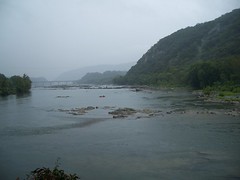 We started off our field experiences with a trip to Harpers Ferry National Historical Park. We were all up early in the morning, bright eyed and bushy tailed as the expression goes, and although it looked like rain we started off in high spirits. At the visitor center we met Dennis Frye who would be leading us on the battlefield, and other battlefields to come. Harpers Ferry is an amazing place because it is known for more than one famous occurrence. The two that come to mind are the 1859 raid by John Brown and the September 1862 Civil War battle.
We started off our field experiences with a trip to Harpers Ferry National Historical Park. We were all up early in the morning, bright eyed and bushy tailed as the expression goes, and although it looked like rain we started off in high spirits. At the visitor center we met Dennis Frye who would be leading us on the battlefield, and other battlefields to come. Harpers Ferry is an amazing place because it is known for more than one famous occurrence. The two that come to mind are the 1859 raid by John Brown and the September 1862 Civil War battle.We began with the battlefield since the change of rain was worse for the afternoon. Dennis took us first to Bolivar Heights to get a perspective of the battlefield. Harpers Ferry is at the junction of the Shenandoah and Potomac Rivers and is a triangle of "high-ground" made of Bolivar Heights, Maryland Heights, and Loudoun Heights. In the present day it is also the junction of three states: Maryland, Virginia, and West Virginia. Dennis took us to both the Union and Confederate lines and the locations of the major movements during the battle. Harpers Ferry is a well preserved battlefield and we were able to get a really good feel for the movement of the battle in 1862. We walked the confederate lines on Schoolhouse ridge and, even though we have a lot of work to do before we can march in a respectable line formation, it was easy to see the courage of the soldiers that fought on both sides of the conflict.
 Even though it had been raining all day and was getting heavier we went back out on the field after lunch. This time we went out to the Old Town where John Brown's Raid had occurred in 1859.
Even though it had been raining all day and was getting heavier we went back out on the field after lunch. This time we went out to the Old Town where John Brown's Raid had occurred in 1859.Unfortunately for the town, the Civil War had caused so much damage that it never fully recovered and 60% of the original town is no longer there. Dennis brought us to the site of the armory buildings that John Brown and his men had attacked to get arms to fight Brown's own war against slavery. The only original building significant to the raid that still stands is the engine house where the final assault by the US Marines occurred and John Brown was captured. Sitting inside the tiny building Dennis took us through the events of the raid and the dramatic conclusion that reverberated throughout the states and impacted opinions on slavery just two years before the Civil War would begin.
Wet and tired but full of new knowledge we headed home to the Appleford. Next week Manassas!!!
